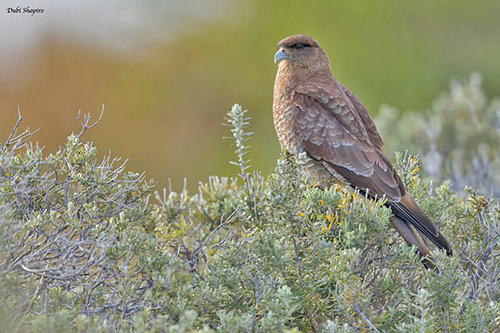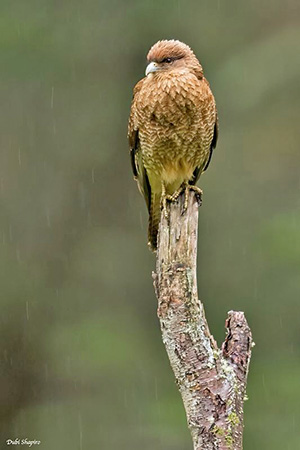
Fr: Caracara chimango
Ang: Chimango Caracara
All: Chimangokarakara
Esp: Caracara Chimango
Ita: Caracara chimango
Nd: Chimango
Sd: chimangokarakara
Photographers:
John Anderson
John Anderson Photo Galleries
Didier Buysse
Vision d’Oiseaux
Eduardo Andrés Jordan
MIS AVES – AVES DE ARGENTINA
Dubi Shapiro
Dubi Shapiro Photo Galleries
Text by Nicole Bouglouan
Sources:
HANDBOOK OF THE BIRDS OF THE WORLD Vol 2 by Josep del Hoyo-Andrew Elliot-Jordi Sargatal - Lynx Edicions - ISBN: 8487334156
Sistema de Información de Biodiversidad
First Record of the Chimango Caracara (Milvago chimango) Using Shrimp as Prey
Aves de Chile
PLANETOFBIRDS.COM
Wikipedia, the free encyclopaedia
Chimango Caracara
Milvago chimango
Falconiformes Order – Falconidae Family
INTRODUCTION:
The Chimango Caracara is found in the Southern Cone of South America, and the species was introduced to Easter Island, between 1910 and 1920. Two subspecies share this large range.
It occurs in a wide variety of open landscapes, but also in villages and urban areas. It is mainly observed below 2,000 metres, but it is regularly seen up to 3,000 metres, and occasionally as high as 4,000 metres of elevation.
The Chimango Caracara is omnivorous, feeding on live prey from insects, reptiles, amphibians to rodents, but it also scavenges roadkill and carcasses of large animals killed by other predators.
It usually forages on the wing, by flying low above the ground and dropping onto the detected prey item.
The Chimango Caracara may nest solitarily or colonially. The nest is built in tree, between 3 and 30 metres above the ground, although some nests can be found on the ground among the vegetation, or over water in dense tussock. Both adults share the nesting duties.
The Chimango Caracara has a very large range where the species is common, and the population is suspected to be increasing. The species is not globally threatened at the moment.

DESCRIPTION OF THE BIRD:
Biometrics:
Length: 37-40 cm
Wingspan: 80-99 cm
Weight: M: 289 g – F: 300 g
The Chimango Caracara is the smallest variety of caracara.
The adult male of nominate race has cinnamon-brown plumage on the upperparts. Mantle and back are edged with cinnamon-brown and the feathers have white tips, forming a soft, scaled pattern.
The uppertail-coverts are white. The tail is mottled greyish and white, and we can see a broad black band near the end and thin white tips to rectrices.
On the upperwing, the flight-feathers are darker brown with a conspicuous white wing patch at base of primary flight-feathers. This pattern is well visible in flight.
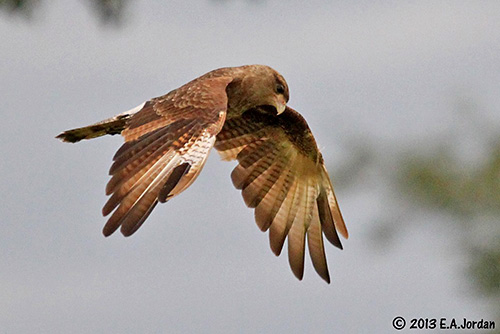
The underparts are slightly paler, mottled and barred with rufous-brown. On the underwing, the flight-feathers are barred with black, except the primaries.
The head is cinnamon-brown with darker, almost black stripe on forehead, extending around and behind the eye, almost forming a dark mask. Chin and throat are paler, mostly buff or brownish-white.
The stout bill is horn-coloured. Both cere and facial skin are orange-yellow.
The eyes are chestnut-brown, surrounded by bare yellow eyering.
Legs and feet are yellow with black claws.
The adult female resembles male, but she has reddish-pink facial skin and bluish-grey legs and feet. The eyes are dark brown.
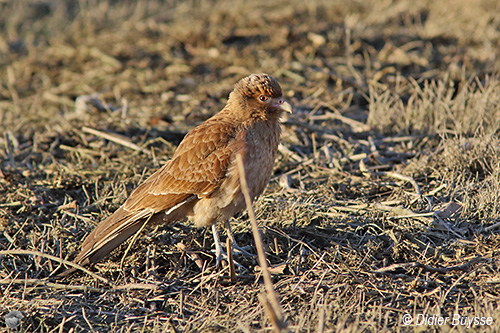
The juvenile shows strong rufous tinge, often with white spots on the back. The breast is streaked. On the head, the mask around the eye is visible, but it is mostly dark brown.
The bare parts including eyering, facial skin, legs and feet are pale blue. The bill is generally pale blue to whitish.
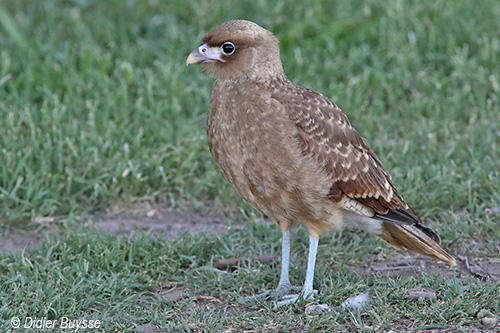
SUBSPECIES AND RANGE:
The Chimango Caracara has two subspecies.
M.c. chimango (described above) is found in the forests of S Brazil and Paraguay, to C Argentina and C Chile.
M.c. temucoensis occurs in S Chile and S Argentina to Tierra del Fuego and Cape Horn Archipelago. It winters in C Paraguay and adjacent Brazil.
This race is darker than nominate, with smokier brown plumage often more heavily marked.
HABITAT:
The Chimango Caracara frequents natural grasslands, cultivated fields and pastures, and generally a variety of open areas.
It is observed in the Andes in grassy foothills, heathland, shrubland, fields, open woods or plantations.
The species is frequently found at edges of water in marshes, on beaches and sandbanks, and river valleys. It also frequents villages and towns where it occurs in urban parks. It is often seen near roads where it takes advantage of numerous road kills.
The Chimango Caracara is usually visible below 2,000 metres of elevation, but there are some records up to 4,000 metres, and it is regularly seen up to 3,000 metres.
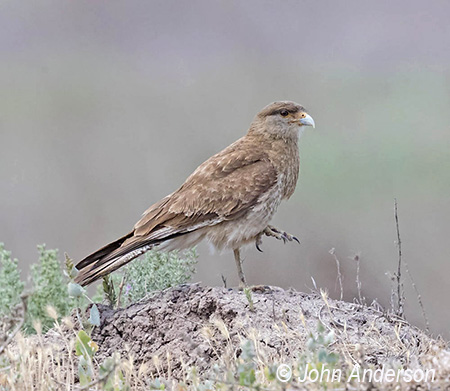
CALLS AND SONGS: SOUNDS BY XENO-CANTO
The Chimango Caracara becomes vocal during the breeding season, when it performs some displays. During this period, it often throws its head back while producing a petulant-sounding “keah-keah-keah…”or “ke-ew, ke-ew, ke-ew”.
We can also hear squeals, growls and hissing whistles commonly given near the nest or against intruders during the nesting period. Another call, a loud, high-pitched “keeeeee-eh” is generally uttered singly and often in flight.
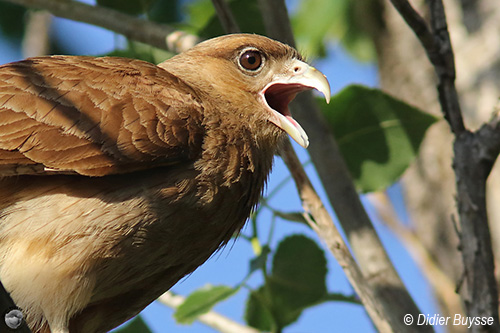
BEHAVIOUR IN THE WILD:
The Chimango Caracara is also a terrestrial species, foraging by walking in open fields, roads and shores. It is often seen in villages, approaching human settlements to find food and refuse.
It feeds on a large variety of invertebrates including insects, slugs, worms and larvae. It also feeds on amphibians and reptiles, eggs and nestlings of birds nesting on the ground, rodents, and small fish, shrimps and turtle eggs on beaches.
It also takes carrion such as road kills, and picks ticks off the backs of cattle. It may take occasionally small amounts of seeds and berries, rotten apples and fungi.
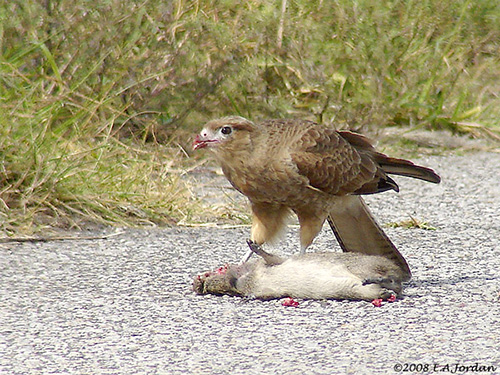
While hunting, it jumps and runs after a prey, but it forages largely on the wing, often in random manner, flying between 3 and 10 metres above the ground before dropping onto the prey.
It may attack other birds of prey or large waterbirds, and it was observed pirating food from American Oystercatcher.
Some individuals also catch live fish from the water surface.
The Chimango Caracara also forages in groups, especially at grass fires. It also frequents fishing villages or follows farmers while they plow the fields.
It is opportunistic and omnivorous, feeding in various areas including marshes, beaches, open fields, roadsides, villages and urban parks.
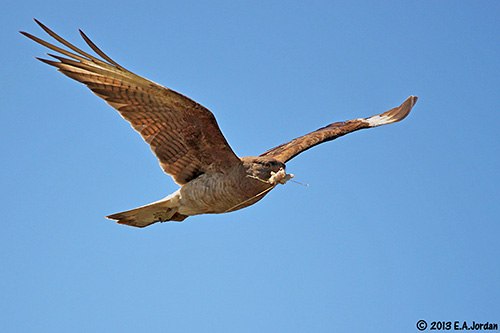
During the breeding season, the Chimango Caracara becomes more vocal. It calls at intruders (including humans) approaching the nest site. It is often vocal near the nest, calling while throwing the head back.
This species nests solitarily, in colonies or in small groups, depending on area and range. The nest is a platform made of sticks, built in tree, on the ground or in tussocks in marsh.
Both adults share all the nesting duties.
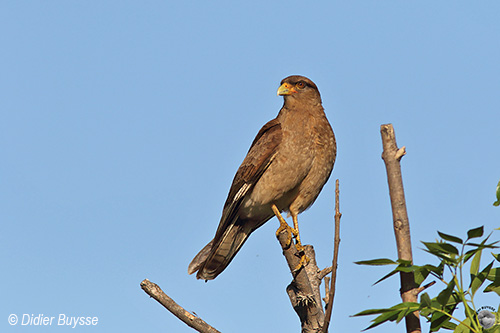
The Chimango Caracara of the southern populations is partially migratory and moves north as far as NW Argentina during the austral winter.
The birds of the northern populations move into Bolivia during the non-breeding period, and in small numbers as far as north in Brazil.
Some vagrants (3-4 individuals) are recorded to the Falkland Islands.
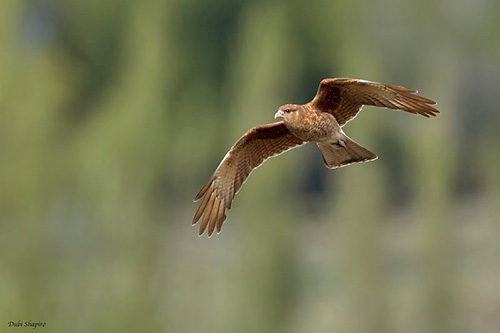
The caracaras belong to the Family Falconidae, like the numerous falcon species, but if the “true” falcons are credited with extraordinary powers of flight, the caracaras tend to be slow, rather mechanical fliers.
When foraging, it flies low above the ground, often in random manner, before dropping onto the prey.
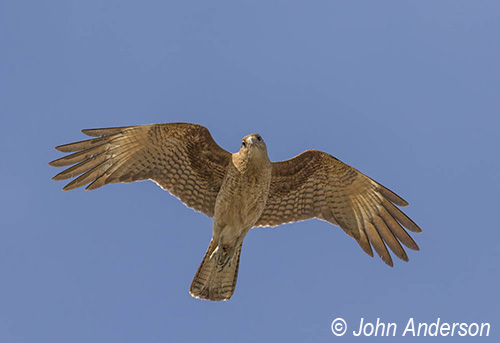
REPRODUCTION OF THIS SPECIES:
The breeding season takes place between September and December, with peak in October to mid-November in most parts of the range.
The Chimango Caracara nests solitarily or colonially. At one site in Argentina, a colony of 56 nests was found, with the nests built 4-10 metres apart.
The species nests in trees, between 5 and 15 metres above the ground, sometimes up to 29-30 metres. However, it may also nest on the ground, among tall grasses and rushes, or over water in dense tussocks.
The nest is built with sticks and lined with wool, feathers and plant material. It is usually well concealed. The nests built near or on the ground are oriented to protect them against strong winds.
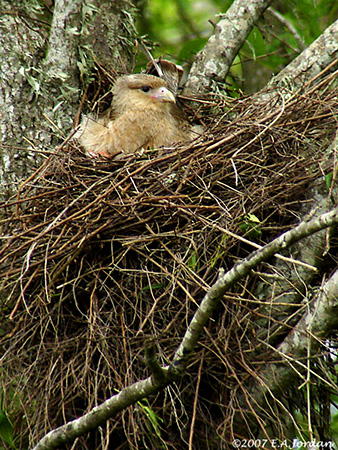
The female lays 2-3, sometimes up to 5 pinkish-buff eggs with pale reddish markings. Both adults incubate during 26-32 days, starting with the first egg.
At hatching, the chicks have yellowish down. They are fed by both parents, and fledge 32-41 days after hatching.
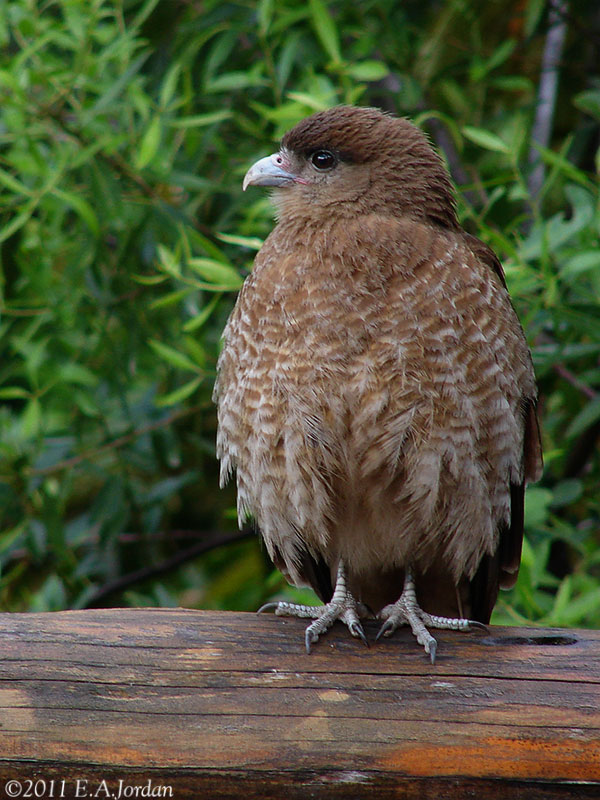
PROTECTION / THREATS / STATUS:
The Chimango Caracara has a very large range where it is common and regular. It is the commonest raptor through Chile and Argentina. It probably benefits from deforestation, as it frequents a large variety of open areas.
However, it is apparently predated by the Black-chested Buzzard-Eagle in Patagonia.
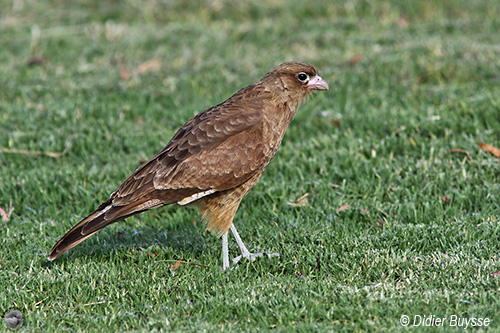
The population is suspected to be increasing, as the species is thriving close to human settlements where it feeds at rubbish dumps, especially in fishing villages.
The Chimango Caracara is currently evaluated as Least Concern.
